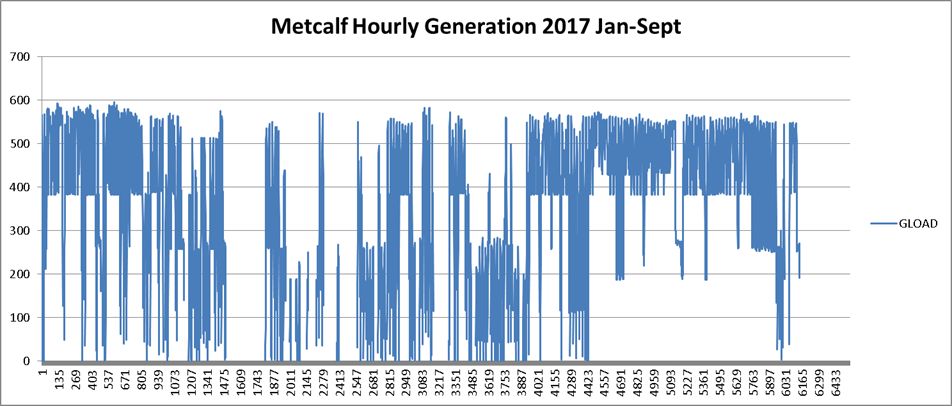California regulators rejected an effort to award lucrative "must-run" status to three Calpine gas plants, calling for new energy storage and clean resources instead.
The California Public Utilities Commission ruled Thursday to authorize PG&E to procure energy storage or preferred resources (such as demand response or distributed solar) to ensure local reliability in areas previously served by the gas plants. The new resources can be individual or aggregated, and must be available by 2019 "if feasible and at a reasonable cost to ratepayers."
This appears to be the first time a utility will procure energy storage to replace existing gas plants for local capacity needs. In Oxnard, a procurement process has begun to select storage instead of the proposed Puente gas plant. California deployed more than 100 megawatts of storage to shore up capacity after the loss of a major gas storage facility in the southern part of the state.
In this latest decision, though, regulators have chosen storage as a potentially cheaper alternative to maintaining two gas peakers and a 580-megawatt combined cycle plant. This process could become a playbook for phasing out more gas plants that become uneconomical in the future.
"The commission is showing confidence in the idea of preferred resources and energy storage as an alternative to the gas assets that currently provide reliability," said Katie Ramsey, staff attorney at the Sierra Club, which filed a motion in support of the proposal. "This is a signal that clean resources don't just compete with new gas plants -- they can also perform the same services as existing gas plants."
The case will test the economics of storage compared to existing gas infrastructure, and whether batteries in practice can provide the full range of services that a large gas plant performs.
Irregular procedure
The decision hinged in large part on a procedural irregularity.
The California Independent System Operator, which oversees grid reliability, awarded "reliability must-run" (RMR) status to the Yuba City, Feather River and Metcalf Energy Centers. This designation covers the full costs of operating the facilities, to ensure they're available for days of extreme grid need. That means ratepayers end up paying a lot of money for plants that seldom run.
Typically, competitive resource adequacy solicitations precede the awarding of RMR contracts, which serve as a backstop if the normal procurements don't cover all the determined capacity needs. The resource adequacy (RA) program was designed explicitly to reduce reliance on RMR designations, and it has achieved that goal to a significant degree, the CPUC said.
Calpine declined to compete for resource adequacy, or for the capacity procurement mechanism, which backstops the resource adequacy program. "Instead, the company elected to communicate to CAISO that it was planning to make these resources unavailable for CAISO dispatch unless each was awarded an RMR contract," the decision states.
That sounds a bit like a shakedown: Give us the lucrative deal or lose the vital resources. But in actuality, it's a little more complicated than that.
Calpine says the RA process wouldn't provide sufficient funding to keep the plants online. It also needs to conduct pricey maintenance on the Metcalf plant, and the timing of the capacity procurement mechanism wouldn't allow enough room to plan for that.
The resource adequacy process has its own issues.
It only looks a little over a year into the future, so it is not conducive to longer-term planning for plant operators. Also, the CPUC allows utilities to count solar resources as firm capacity equal to 80 percent of nameplate capacity; this should be closer to 40 percent given the inability to serve evening demand, said Wade Schauer, research director at Wood Mackenzie's Americas Power & Renewables team.
Changing that solar accounting would mean many more gas-fired generators receive resource adequacy payments, he added, and Metcalf likely would be one of those.
Prices in the California energy market are enough to cover the variable operating costs of gas-fired generators in the state, but not the fixed operating costs of many plants. Such plants need resource adequacy payments or RMR contracts to keep them viable. Many are barely breaking even, such that expensive repairs can derail plant economics.
Part of the challenge stems from an oversupply of power: The California ISO has about 7,000 megawatts of surplus capacity today, Schauer said. That leaves room to lose some of the least economic gas-fired plants, but about 7,000 megawatts of older plants are already set to retire by 2021 due to a regulation on plants that use ocean water for cooling.
"The surplus that exists today will be gone in four to five years, putting the state on the edge of a capacity shortfall," he said.
Bulk power plants put on notice
The new solicitation will be a test case for comparing the economics of new batteries against the operating costs of existing peakers. That's a heavier lift for batteries than competing with the upfront costs of a brand new peak power plant, as in the Puente case.
The CPUC asserted that the clean resources can likely cost less for ratepayers than keeping the three plants online, but Schauer questions that claim.
"I'd be surprised if PG&E can procure new batteries for less than paying the fixed RMR costs of the Calpine units," he said. "However, PG&E is encouraged to accelerate the procurement of their existing 2021 storage mandate, which could be thought of as a sunk cost. In that sense, the accelerated battery deployment may be on par with or cheaper than RMR contracts."
The argument for batteries as peak capacity is fairly straightforward: Instead of paying for an asset that sits idle most of the time, batteries can multitask, earning revenue when the grid isn't in need of extra power.
"Energy storage resources provide additional value outside of just those emergency circumstances when you need to call on them," the Sierra Club's Ramsey said.
The energy storage industry has been arguing for that switch for a long time. The likely replacement of the Metcalf plant by storage, though, raises a whole new set of questions. That plant didn't play a peaker role; it produced a lot of power a lot of the time.

The Metcalf plant's operational history leaves big shoes for batteries to fill (graphic by Wood Mackenzie using EPA data)
Runtime data from the plant suggests that, though it often shuts off around noon when solar production surges, it regularly fires up close to its full 580-megawatt capacity by the evening peak, around 8 p.m.
Batteries could take over Metcalf's local reliability duties, but it's harder to see them filling the broader role the plant serves for the grid, Schauer said.
"If we get a 110-degree day in August 2019 and there are rolling blackouts because the batteries ran out of juice after 4 hours and we needed them for another 8 hours, maybe the PUC would rethink getting rid of gas-fired generators," Schauer said. "Until then, that seems to be the objective the state legislature and the PUC are after."
California's grid currently relies on flexible gas capacity to step up when the intermittent renewables fade. The CPUC's action Thursday reveals a willingness to push the system toward cleaner assets for peak capacity and reliability.
An orderly transition could lead to cleaner air, lower carbon emissions and potential savings for ratepayers. If there are hiccups along the way, like gas capacity going out of business or retiring faster than replacements can be brought online, ratepayers are going to feel that too.




